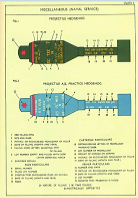The Split Hedgehog which was used in some sloops and other small ships where it was necessary to retain the forward gun. These mountings held 12 projectiles each and one was placed on each beam, near the bridge. These were coupled together, initially with wire ropes, later by hydraulic jacks. About 35 ships were so fitted between 1942 and 1943. ML 472 had a Half Pattern Hedgehog consisting of 6 projectiles each side.
Projectiles had a diameter of 7 inches (18 cm) and weighed 65 lbs. (29.5 kg) with an explosive charge of 35 lbs. (15.9 kg) of Torpex. Sinking speed was 22 to 23.5 fps (6.7 to 7.2 mps).
ML 472 was an experimental anti-submarine trials vessel based at Farlie in Scotland, at the Underwater Weapons Research Establishment. Between times she served at Tobermory, Under the overall command of the redoubtable "Puggy" (or "Monkey") Stephenson, Vice-Admiral (retired), serving as Commodore Western Isles, at the initial working-up base for all types of escort and A/S vessels.
When he joined, the new CO of ML 472 found the ship in poor repair and the crew's moral low. She had not had a refit, or her crew leave, for some time. A half-pattern Hedgehog A/S mortar had previously been fitted on the focs'l, with inadequate stiffening. Trials of that weapon were being carried out with the original fixed ASDIC, and each time the weapon was fired the deckhead opened up; the deckhead was very wet as a result. A report was written to Commodore Stevenson detailing her defects, and with the support of the NOIC at Fairlie (whom the new CO had known at Cambridge), another report was submitted suggesting that the trials be postponed until she had been refitted and rearmed. Within a short time, ML 472 was sent to Robertson's yard at Sandbanks (Holy loch) for a long refit, rearming and new asdic gear. New RDF (radar) was also specified. The CO recommended that it should not be fitted unless the funnel and other top weight were removed, and dumb-flow side exhausts fitted. The constructors turned down that proposal, but because the inclining that followed raised concern about her stability, the fitting of RDF was quietly forgotten. Like the fixed A/S gear, the RDF equipment was anyway very indifferent, except in the still and sheltered waters of Seahawk.
However, the new training asdic and aircraft-type gyrocompass, together with the split Hedgehog, was "splendid equipment". On their return to Farlie, ML 472 and her crew had much success hunting "Mickey Mouse" midget submarines, in weather up to Force 6-7. Later, returning to Tobermorey, she found herself acting as a target for radar calibration trials for big ships.
Allied Coastal Forces Of WWII. John Lambert & Al Ross ©

